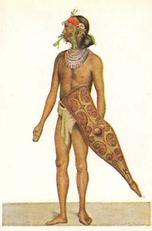Subject: kerei shaman
Culture: Mentawai
Setting: tribal warfare, Mentawai Islands 19-20thc
Evolution:
Context (Event Photos, Primary Sources, Secondary Sources, Field Notes)
* Lindsay 1992 p87
"Healing is the essence of shamanism. Once the kerei are called and accept the appeal to rid someone of an illness, all other work becomes taboo. They may not leave until the ailment is cured or they are dismissed. Though the normal payment might be a chicken or piglet, it is not expected nor would it be the motivation for healing."
Costume
* Lindsay 1992 p116 (Reimar Schefold, "Shamans on Siberut" p105-117)
"... [T]he articles that are the exclusive garb or equipment of the shamans [are] a hair decoration of feathers and the ribs of palm leaves, a necklace of ocher-colored cylindrical glass beads, a dancing apron fashioned from pieces of cloths of diverse hues, a headband, and woven upper-arm rings studded with beads."
* Lindsay 1992 p11
"... [L]oincloths, tattoos, and long hair [are] the pride of the kerei."
* Lindsay 1992 p55
"Nudity and embarrassment are serious issues for the Mentawaians."
* Lindsay 1992 p61
"Tattoos are an extension of Mentawaian clothing. They are applied by a designated tattooist at specified stages in life. A donation of one chicken is the usual payment. First the chin and back are tattooed, then hands, chest, thigh, and buttocks. The shins come last. Patterns vary slightly in different regions. Traditionally, the first session occurred at about age seven ....
Knife
* Stone 1934 p480
"PALITAI, PALITE. A knife, Mentawi and Siberut. They have straight, double-edged blades and long, slim and curiously curved handles."
* Greub 1988 p180
"The daggers of the Mentawaians -- variously called parittei, palittei, or pattei -- have iron blades, which are obtained by barter from Sumatran traders as blanks and then ground into shape. These blades are also used to tip spears. The wooden sheath consists of two parts, the two sides usually being secured together at the bottom by a bone ring and at the top by a binding of rattan, dyed red. The lower end of the sheath is often curved. The solid wood handle is curved still more sharply. As a rule this is ornamented in the middle by a thickened ridge and ends in a spiral, the head of a cock, or a human. In the latter case the eyes generally consist of nacre disks or glass beads. The wooden parts are frequently colored red with vegetable pigments, and sometimes there are incised decorative patterns, the grooves of which are subsequently filled with black resin.
"The daggers are tucked into the loincloth on the right-hand side. On Siberut, the northernmost and largest island of the archipelago, they form a fixed part of the bride price. Formerly they were carried on head-hunting expedition. On the Pagai Islands farther to the south, both bride price adn head-hunting were things of the past at the time of the first ethnographic reports in the last century. Although there is thus no information concerning the specific circumstances of their use in the southern islands, it is precisely from there that especially fine specimens have been obtained."
* van Zonneveld 2001 p95
"The hilt of the palitai is thin and long, at the blade still rather broad but becoming thinner to run long and elegantly into an almost sharp tip or a decorated end. This hilt has a round thicker part just past half way. On the northern islands (Siberut, Sipora) the hilt is rather simple, on the southern islands (north and south Pagai) it is curved more elegantly in the shape of a swan's neck with a curl (similar to a closed fern leaf) at the end. Other decorations, such as a stylised head of a cock or bird are found, too. This hilt may have carvings filled with resin. The scabbard has the same shape as the blade and may be smoothly finished. However, decorations with chicken feathers and rattan ties at the mouth also occur. Sometimes the scabbard has a bone or deer-horn tip.
Shield
* Stone 1934 p200
"KURABIT. The shield of the Mentawei Islanders." [reference omitted]
* van Zonneveld 2001 p77
"KURABIT [KURAIBI] MENTAWAI ISLANDS A long, slightly curved wooden shield. Its straight upper side is rather broad. Looking down on it, the shield becomes a little narrower and then somewhat broader until about halfway. From here it tapers towards a blunt tip. Just above the centre the grip is cut out of the shield. The subsequent holes are covered using half a coconut shell attached by means of rattan. A kurabit is usually decorated with geometrical, coloured motifs on both sides. Spirals (patogalik) are much used. Moreover, we see decorations such as lizard and human figures in 'rock painting style'. To make red paint, the fruit of the kalumangan tree is used. The black paint consists of soot mixed with plant juices. Since the termination of head-hunting and of disputes between Mentawai ethnic groups at the beginning of the 20th century, the kurabit has become very rare. The older examples seem to be less broad and less curved than more recent ones."
* Benitez/Barbier 2000 p148
"According to some authors, these shields were employed during headhunting rituals. Although light, it would seem that they would have been adequate to stop the Mentaweians' flimsy arrows, whose effectiveness lay primarily in their poisoned tips."
